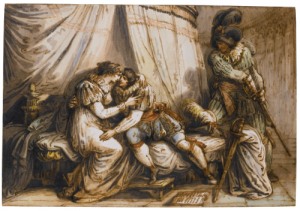Biography

GIANI Felice, painter (San Sebastiano Curone 1758 – Rome 1823). Son of Giulio Domenico, wheat merchant, and Angela Maria Callegari, he spent his childhood in the small Tortonese village of Val Curone, a crossroads of different cultural areas along the route of the ancient roads that connected Liguria, Piedmont, Lombardy and Emilia.
His first training took place in Pavia with the painter Carlo Antonio Bianchi, then he went to Bologna, where between 1778 and 1779 he was a pupil of the Gandolfi (more Ubaldo than Gaetano), Domenico Pedrini and the architect Vincenzo Mazza.
He moved to Rome and became fond of classical antiquities and continued his studies with Pompeo Batoni and Cristoforo Unterberger. He lives in vicolo Sant’Isidoro and attends the lively artistic cenacles of the capital, tying up with the young artists of German culture (Giuseppe Bergler, Michele Koch) through whom he gets to know the works of Fussli and Flaxman who will have a significant influence on his subsequent artistic evolution. He obtained two second prizes in important competitions: first (1783) at the Academy of San Luca with the beautiful sheet (watercolor and china) Jesus chases the merchants from the temple; then (1784) at the Academy of Fine Arts in Parma. The first Roman activity sees him engaged in the decorations of Villa Borghese and Palazzo Chigi. Between 1786 and 1788 he stayed in Faenza where he frescoed the great Allegory of Peace in the vault of the Galleria dei Cento Pacifici and then painted the central scene with Apollo and Phaeton in the gallery of Palazzo Conti. A trip to Herculaneum and Pompeii pushes him to use archaeological references in the decorations of Palazzo Altieri in Rome, then from 1794 he starts an intense and appreciated activity of decorator in the aristocratic residences of different cities in Emilia and Romagna: in Faenza where he is the true protagonist of that figurative culture that would shortly transform the face of the city (see the gallery of Palazzo Laderchi and the rooms of Palazzo Milzetti); in Bologna (see Palazzo Aldini and Palazzo Marescotti); in Forlì, Ravenna and Ferrara. In 1811 he returned to Rome to decorate the Napoleonic apartments at the Quirinale, and then landed in Paris, where he carried out the decorations, now lost, of Villa Aldini in Montmorency.
One of the most significant artists of the neoclassical age, he adopts a composite style: alongside decisive shots and reworking of the ancient, his works have unmistakable mannerist reminiscences. In the same way, the dense texture of the drawing, always fragmented and energetic, gives a particular emphasis to his paintings, revealing an expressionist and visionary taste.